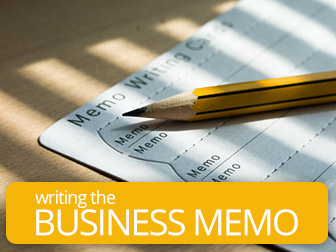The “tweet,” the common term for a short note posted on Twitter (e.g.: “My printer just jammed. Darn it!”) It has its own genre rules: brief--typically one or two lines—personal, and often inconsequential. There are exceptions to this, of course—I know people who use it for various kinds of advertising, for example. But its brief and personal nature convinces me that it is the communication of our times.
Sometimes, however, students may be called upon to engage in other written genres with different requirements, such as the business memo, which is also short, although not as short as a tweet.
Not only is it short, but it’s also concise, or short and focused on important issues, and that is where it departs from the tweet. Students should learn the features of a memo as they will be called upon to write them in the future.

Features of the Business Memo
-
1
“To,” “from,” and “subject” lines
These three lines found at the top of the memo are familiar to students through email. These lines immediately focus the reader on who sent the memo and why.
-
2
Brief
The main feature a professional memo has in common with a tweet is its brevity. However, the memo is also concise, meaning that important concerns are packed into its short space and addressed in an economical way. So instead of the tweet’s short but not necessarily concise “The printer jammed, darn it, but I did discover the handy door in the back to clear the printer,” an observation the reader can’t necessarily do anything with, the memo will state, “The printer keeps jamming. The repairperson needs to be called. If that doesn’t resolve the matter, a new printer may need to be purchased.” In not much more space than the tweet, the writer of the memo has let the reader know the reason for the communication and suggested a couple of courses of action.
-
3
Purposeful
Focused on professional rather than personal issues. The writer of the memo has an at least implied purpose—get the printer repaired—while the writer of the tweet has no real purpose beyond the communication itself and establishing a connection with the reader.
-
4
Impersonal in tone
A simple observation is made in stating “The printer keeps jamming and needs to be repaired.” By using the passive voice—“needs to be repaired”—the author is not assigning blame nor handing out the task of repair. It is for this impersonal tone that the passive is used in business so much. This tone is in stark contrast to the personal tone often found in tweets and other informal written communication: “The printer jammed! Those darn kids have been messing with it again…”

Teaching the Business Memo
-
1
Define it. Show an example
Students are likely to have never seen a memo. Show a simple example on the projector and analyze its various parts, such as the heading, message portion, and signature line.
-
2
Compare it to other genres students are more familiar with
How is a memo like an email? A tweet? A text? Discuss how the different forms are alike and different, perhaps outlining those differences on the board in columns. Discuss why the differences exist and the audiences each form is directed at. In this way, students begin to develop a sense of audience and genre expectations.
-
3
Discuss situations where the memo is needed: announcements, requests, reports
To further develop this sense of genre, discuss situations in which the memo is used: typically announcements, e.g., “We have the pleasure of announcing that Ms. Jan Smith will be joining us as the new administrative assistant…” or “Parking Lot A is being resurfaced. Please use Parking Lot B until further notice.” Requests are also often made in memos: “Your assistance is requested in disposing of food items in the kitchen rather than office garbage, as the smell can get quite strong sometimes…” In addition, short reports are sometimes made in memos: “The milestones for our fundraiser were all met successfully this year, with a total of X dollars raised.” By analyzing these examples, students begin to gain a sense of the genre expectations.
-
4
Analyze the format
Have students take a more detailed look at the example or examples, noting what typically comes first, where the “meat” of the message is, or the main point, and how the writer draws the message to a close. By looking at several different memos with different topics but with the same format, students will begin to understand the genre format.
-
5
Practice
Finally, have students come up with their own topics or assign topics, perhaps on 3x5 cards, to each student. Also assign partners and have students write memos to each other on a topic, such as addressing increased employee tardiness. Students can discuss the topic with each other briefly and then write the memo to their partners. They may write in long hand or on computers if your classroom is computer-assisted.
In summary, the tweet and the memo are not only two different types of writing; they represent the different genre expectations of the personal and the business world.
In introducing and teaching the business memo, the teacher introduces the expectations of professional written communication: concise, goal-oriented, and impersonal, which is very different from the personal and informal written world students have inhabited so far, but it is this business world they are on the cusp of entering.
P.S. If you enjoyed this article, please help spread it by clicking one of those sharing buttons below. And if you are interested in more, you should follow our Facebook page where we share more about creative, non-boring ways to teach English.







